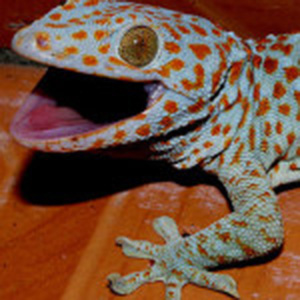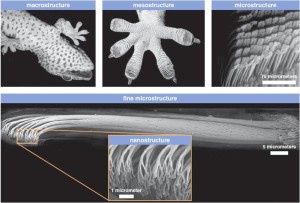|
SUPERADHERENCE - GECKO FORCE
|

By Nick Hobgood (Flickr) [CC BY 2.0], via Wikimedia Commons
 By Autumn, K (“How gecko toes stick”, American Scientist 94, 124-132) [CC BY 3.0], via Wikimedia Commons
By Autumn, K (“How gecko toes stick”, American Scientist 94, 124-132) [CC BY 3.0], via Wikimedia Commons
|
Geckos are small tropical lizards which defy gravity when they climb on vertical surfaces and hang from the ceiling. Their feet are adherent and in theory can stick to ceilings and support 130 Kg of weight. How do they do it? Geckos use "Van der Waals" force. Compared to other common chemical links, these forces induce relatively weak interaction between molecules and very small objects due to the presence of natural electromagnetic fields which fluctuate very rapidly. However, combining "Van der Waals" forces from millions of small hairs, geckos manage to stick to a surface. In fact, researchers have discovered geckos' feet are equipped with thousands of very fine hairs (setae) which measure 0.1 mm in length. Each hair has hundreds of branches which end in a spatula shaped structure of 100-200 nanometres. These spatulas provide geckos with the necessary contact area. In fact, each seta can support the weight of an ant and one million of them could support the weight of a small baby. Abigaille, a climbing robot for space Using nanoengineering, synthetic hairs 100 times bigger than gecko hairs have been created enabling the robot to stick to the wall. Examples in nature Geckos, small (wall) lizards and certain spiders. Possible applications Gloves for wall climbing; bandages and other medical tools more efficient than current ones; new tools for mountain climbing; more powerful adhesive tapes. |










